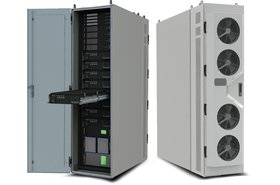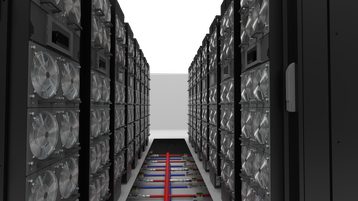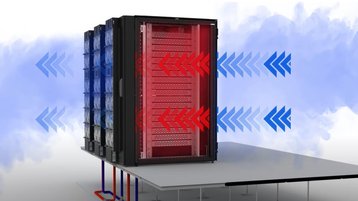A common fallacy has begun to emerge in the data center industry. As we move towards ever-increasing workloads, fuelled by the rise of artificial intelligence (AI), there has been a march towards liquid cooling as the zenith for keeping your precious multi-million dollar racks running as they should. However, an assumption persists that retrofitting liquid cooling involves expense, construction work, and possibly even downtime.
Stefan Djuranec, nVent’s global product manager, DNS cooling, has a better idea. We caught up with him to talk about the advantages of rear door heat exchangers (RDHX) as a near plug-and-play alternative that brings the advantages of liquid cooling to new builds but can also be easily incorporated into existing facilities.
At its simplest, and as the name suggests, an RDHX, or rear door cooler, sucks in warm air generated by equipment, cools it, and expels the chilled air out the rear door. The main difference is that, rather than being processed in a specially equipped area of the data center, the cooling is done right next to the rack itself. Djuranec explains why this is an advantage:
“With traditional CRAH or CRAC (Computer Room Air Handler/Conditioner) units, the cooling is far from where it’s needed, so you must duct the air to and from the cooling equipment. With rear door cooling units, they’re right there, in the row of racks – no long pathways, no air ducting.”
Rear-door coolers use elements containing water-glycol solutions. Whereas air is a natural thermal insulator, water is a more effective transport medium for removing heat. Djuranec tells us:
“We’ve used air in the past because air is a good transport medium in that it’s practical, non-conductive, and chemically stable, but water is a much more effective means to transport heat. You don't need to transport the heat with air over large distances. You transfer the heat from the air directly, at the rack level, into a better medium, which comes with efficiency benefits and energy savings.”
Efficient synergy
One of the efficiencies is that the chilled air exiting the RDHX acts as a natural chiller for the rest of the room, meaning that as well as the concentrated cooling for each rack, it lowers the ambient temperature of the data hall for lower-intensity workloads. With the right guidance, the implementation of RDHX solutions for intense workloads can create a potential saving on conventional cooling.
While opinions vary in terms of exactly who needs to switch to liquid cooling, Djuranec suggests that its efficiencies could make a switch to an RDHX advantageous in any scenario as it offers futureproofing for a time when traffic inevitably increases in the years to come:
“It can be a high-performance computing solution, but it can also be a high-efficiency cooling solution. Especially when, as in recent years, energy costs are rising throughout Europe and the world. The rear door cooler can run with very high water temperatures (compared with CRAH units or in-row coolers) and has a high gain in cooling efficiency. There are two major applications – either you require high performance for cooling or the efficiency gains that rear door coolers can bring.”
This has opened the advantages of rear door cooling to a much wider range of data center clients. Djuranec continues:
“Up to now, high-performance racks have been more utilized in science computing in industrial applications where they are needed to run high-performance simulations. It's a niche environment compared with the broader market of the average consumer and user AI.
“Things have changed drastically because AI is now going into many data centers. Many universities and companies are playing with this technology, and AI requires high-performance racks. It has a lot of attention now in the industry, and these racks require cooling environments where the rear door cooler fits very nicely.”
Retrofitting Liquid
This goes some way to busting the myth that a liquid-cooled data center needs to be built from the ground up. nVent’s range of RDHX products measures a mere 281mm in breadth, meaning they can be placed on both sides of the data center aisle without preventing access for maintenance or compromising health and safety.
With both active (fan-assisted) and passive units available, there are a range of options for making RDHX units work in any environment. This also makes them an excellent consideration for facilities looking to consolidate into a more densely populated data hall. More importantly, they can be installed in a live environment, as Djuranec explains:
“We’ve seen many retrofit applications, and it's not tricky to apply. There might be challenges to overcome, but they have always been solvable. With traditional cooling, it takes some effort to allow liquid plumbing directly to the vicinity of the racks, but if you have a raised floor, you would need to run this pipework through the raised floor.
“If it's underneath the ceiling, you can install the pipework in a live environment, and that’s a common use case. For racks where you want to apply rear door coolers, typically you would start with freeing up space for those high-density racks. You would not usually go with racks from a system that is already up-and-running, but you can work on a live data center running in parallel. It's also simple to add more equipment for rear door coolers.”
Maintenance mythbusting
Djuranec busts another myth as he explains that, contrary to the popular perception of liquid cooling, using an RDHX requires very little extra maintenance compared with traditional air cooling systems:
“Rear door coolers require similar amounts of maintenance as CRAC units and CRAH units. You need to check the water quality regularly, you need to check for leaks, you need to check that things are still fitting tightly, and so on. The difference is that it’s close to the rack, which allows for swapping components quickly and easily.
“Our rear door coolers work with hot-swappable fans that can be changed without tools or training technicians. You can even swap power supplies when they fail without a trained electrician or maintenance personnel. Take the old, failed power supply out, and put the new one in. We call it ‘true-hot-swappable’ because the process can be completed in around 30 seconds.”
“We are unique in the market because we even have a hot-swappable controller. If it fails, the cooler will go into emergency cooling mode. The fans will go on into a default fan speed and the valve will open. It will not provide 100% cooling, but it will provide a minimum level to keep the IT gear running until the problem is solved.”
The other angle to maintenance is the learning curve. Without the talents of well-trained maintenance technicians, no data center will maintain its uptime. So is it difficult to learn how to keep an RDHX running smoothly?
“There are specific things that need to be learned – what about condensation? How does the system react to fan speed control, valve control, and so on? In the first couple of weeks, while technicians get familiar with the device, you will get more questions, but later on, it's silent, especially when a controller is defined or designed nicely and intuitively.”
Plan early, plan with partners
Regular readers of DataCenterDynamics will know that one of the most common pieces of advice we’re given is that the earlier you can engage with partners like nVent, the better the outcomes. We’ve spoken mostly about retrofitting thus far, but that doesn’t mean a rear door cooler doesn’t represent the best option at the blueprint stage of a greenfield build, whether for futureproofing or as part of a hybrid array. Djuranec tells us why maximum benefit can be gained from carefully considering your cooling requirements at the design stage:
“If you plan with rear door coolers from the start, you get instant benefits even from smaller workloads. As they can run at high temperatures, you need fewer or smaller chillers, utilize dry coolers, or have operative cooling as much as possible.
“You can already plan with higher power per rack and plan your electricity accordingly, meaning you don't need to upgrade to a higher service later. As with many other applications, it is much easier to plan for higher loads, and then work with lower loads. If you do it the other way around, it's trickier.”
Djuranec warns of a common trap – it’s impossible to work with multiple workloads using liquid alone, and the dangers of retrofitting air cooling are as manifest as not planning for liquid. A modern data center needs a hybrid solution, planned from the outset, for maximum efficiency.
Granular control
The secret to controlling cooling to those varying workloads lies in an ability to change settings at a granular level. nVent’s rear door cooling units are ‘smart’ by design, with sensors for measuring air and water temperatures, fan and valve health, differential pressure, and fan speed, amongst many others:
“Everything can be monitored, fully remotely. In addition, we provide integration into our Sunbird data center monitoring environment. You can easily make our coolers work in those environments. The standard languages we support are easy to integrate into the end user’s environment. It's very intuitive to operate and work with.” says Djuranec.
In finishing, we look at the thorny issue of waste heat and sustainability. With more countries limiting power available to data centers, RDHX is, according to Djuranec, a good decision for power-conscious operators:
“In some countries, they request a maximum power usage effectiveness (PUE) value for a data center to approve it. Some territories are already limiting the power available for data centers. If you're restricted, you want to go as efficiently on the cooling side as possible to use your space and power for the computer gear.”
Heat reuse gateway
He also points out the value of RDHX as a means of providing efficient heat reuse, another increasing requirement for newly built data centers:
“The value of heat is defined by its temperature. You can’t do much with low-temperature air or water. If you increase the temperature, you can heat water for people to wash their hands or bathe. If you increase the temperature of the return water, then you can drive chemical processes with it.
“Rear door coolers have a high heat exchange surface, high performance, and work at comparatively high return temperatures, which lifts the excess heat to a level usable for district heating, household heating, or industrial processes.”
When all is said and done, Djuranec makes a powerful case for considering RDHX in your plans, whether for retrofit or greenfield. It isn’t the be-all-and-end-all of liquid cooling, but for many situations, it could prove to be the holy grail for a market that continues to evolve at breakneck speed.
For more technical information and to contact us please visit Rear Door Heat Exchangers | nVent
More from nVent
-

MWC 2023: Iceotope pairs with HPE, Intel, and nVent to launch Ku:l Extreme
The Open RAN liquid-cooling solution will support Edge computing across telco data center estate
-

nVent to integrate Iceotope immersion cooling chassis in its racks
Edge and HPC products announced at SC21
-

New rear door coolers from nVent to offer a scalable solution for high-density racks
Providing a scalable, pay-as-you-go, room-neutral solution for cooling high-density racks up to 78kW


